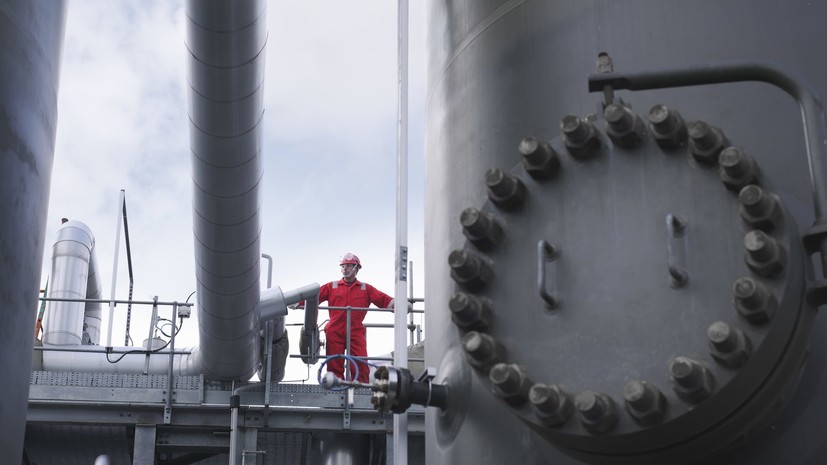On Wednesday, November 23, gas prices in Europe showed an increase.
During trading, the December futures price increased by 12% to €133.8 per MWh, or $1,433 per 1,000 cubic meters.
m, according to the London Stock Exchange ICE.
“The growth of commodity quotations is largely due to the start of the heating season in the EU countries.
The market is playing out the period of abnormally warm weather that was observed in the region in October.
Now the heating has been operating at full capacity, consumption has increased, which affected prices, ”Ronald Smith, senior analyst at BCS World of Investments, said in a conversation with RT.
Another factor in price growth was the news about a possible reduction in Russian gas supplies to the region, the expert added.
On the eve of "Gazprom" said that it had revealed a partial settling in the territory of Ukraine of raw materials, which were intended for consumers from Moldova.
That is, less gas passes through the Ukrainian-Moldovan border than is supplied through the border of Ukraine and Russia.
According to the company's estimates, the total volume of gas deposited in Ukraine amounted to 52.52 million cubic meters.
m. Every day, Gazprom delivers about 42.9 million cubic meters to the Sudzha gas measuring station for transit to Europe.
m of raw materials.
While maintaining the imbalance in supplies, the corporations promised to reduce the gas supply through the channel in the amount of daily settling.
Gettyimages.ru
© Angelo D'amico / EyeEm
In response, Chisinau said that part of the gas remaining in Ukraine is pumped into underground storage facilities (UGS) in order to replenish reserves.
As Deputy Prime Minister of Moldova Andrei Spinu explained, the country has already accumulated reserves in the amount of 200 million cubic meters.
m of gas.
However, he did not specify how much raw material is contained in Ukraine's UGS facilities.
“The players are concerned about the fact that Moscow may soon not only reduce, but completely stop gas supplies through the territory of Ukraine, for example, this winter.
This may increase the shortage of raw materials in the region and is already pushing prices up, stimulating traders to buy more raw materials, ”Natalia Milchakova, a leading analyst at Freedom Finance Global, explained in a conversation with RT.
Since the beginning of 2022, natural gas supplies from Russia to the EU have fallen by more than 80%, according to statistics from the International Monetary Fund.
Thus, delivery via the Yamal-Europe pipeline was completely stopped due to restrictions from Poland, and Ukraine halved the transit of fuel from the Russian Federation to the European Union through its territory.
Also, the pumping of gas through the Nord Streams was stopped after the difficulties associated with the repair of these pipelines and the subsequent sabotage on the highway.
fragile ceiling
Additional pressure on quotes was provided by new EU statements regarding the possible setting of a cap on the cost of gas in the energy market, analysts admit.
This week, the European Commission presented an updated concept of price caps.
As part of the document, it is proposed to introduce a ceiling on gas prices in the amount of €275 per MWh, or about $3,000 per 1,000 cubic meters.
m. At the same time, the restriction will affect only the nearest futures contract and will only be valid on the TTF virtual exchange in the Netherlands.
“The mechanism is extremely targeted, since trading is also carried out on other sites, including over-the-counter.
There is also a spot market.
In fact, the EU itself admits that it is not going to fully introduce restrictions, because if it takes such steps, it will scare off liquefied gas sellers who will switch to other markets, for example, to Asian, ”stated Stanislav, an expert from the National Energy Security Fund, in an interview with RT Mitrahovich.
The proposed price ceiling is significantly higher than current levels, but it is below the peaks to which the cost of raw materials rose in 2022.
Under current conditions, the mechanism will continue to stimulate the flow of LNG to Europe, said Ronald Smith.
“That's why the European Commission offers such a high ceiling price in order to attract suppliers to its market.
As a result, nothing will change for European consumers: gas will be sold at high prices, electricity will rise in price, and inflation will continue to grow.
By the beginning of 2023, the cost of gas in the EU may return to the level of $2-2.5 thousand per 1 thousand cubic meters.
m,” predicts Natalia Milchakova.
EU members are expected to agree on a gas cap in December, writes La Repubblica.
However, not all members of the union are satisfied with this concept of the EC, the Italian edition points out.
Earlier, Hungarian Prime Minister Viktor Orban said that Budapest did not support the introduction of the mechanism, since in this case the country's long-term contracts would be in jeopardy.
Polish Prime Minister Mateusz Morawiecki also spoke out against the adoption of the document: he called the maximum price for the asset “too high”.
According to him, with the help of restrictions, it is necessary to keep the cost of gas at an acceptable level for everyone, and not to set a high bar in advance.
“I think that the EU countries will still come to a single mechanism.
However, the instrument will be of a calm, compromise nature, which will have little effect on world prices for raw materials.
Brussels understands that if they set a limit for everyone, then global players, such as Qatar, will refuse supplies to the region, which will aggravate the energy crisis,” Stanislav Mitrakhovich believes.

